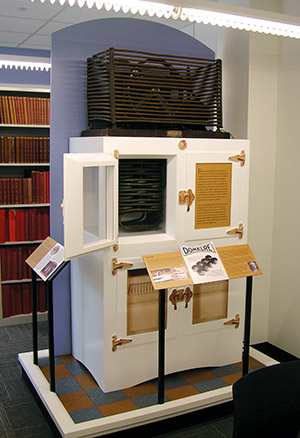ASHRAE displays first electric fridge
23rd June 2015 USA: The last surviving example of a 100-year-old refrigerator, considered to be the first electric household fridge, has been put on display at the ASHRAE headquarters in Atlanta.
USA: The last surviving example of a 100-year-old refrigerator, considered to be the first electric household fridge, has been put on display at the ASHRAE headquarters in Atlanta.
The significant piece of refrigeration history has been donated to ASHRAE from the Frigidaire collection where it has resided since the 1920s. It was installed on the first floor of ASHRAE headquarters on June 19.
The DOMELRE (DOMEstic ELectric REfrigerator) was developed by Fred Wolf Jr in 1913 and marked the first attempt to mass-market a simple, “inexpensive” household refrigerator. That said, it sold for $900, equivalent to the average annual wage at the time.
Fred Wolf Jr was a charter member of the American Society of Refrigerating Engineers (1905), a group that merged with the heating and ventilating engineers to form ASHRAE in 1959. Wolf’s father was one of the pioneers in industrial refrigeration and was responsible for introducing Carl Linde’s ammonia refrigeration in the US. Wolf Jr was inducted into the ASHRAE Hall of Fame in 2014 for his contributions.
Bern Nagengast, ASHRAE historian who arranged for the donation of this 1916 model, said: “As far as I know, it’s the only one in existence. It is a significant piece of both industry and ASHRAE history.”
The DOMELRE was also the first successfully manufactured air cooled system, and the first to be easily portable, being designed as a ready plug in refrigerator unit that could be added to an ice box, instantly converting it to an electric refrigerator. The design also allowed an ice cube tray to be incorporated as part of the evaporator for the first time.
The development of the unit was perfectly described by Bern Nagengast in the ASHRAE Journal in 2004.
He explains that the unit was self-contained, with the condensing unit mounted on a wooden base, and the evaporator hung underneath through a hole cut in the top of the refrigerator.
Wolf’s use of sulphur dioxide refrigerant instead of ammonia, permitted the use of copper tubing for the air-cooled condenser and evaporator instead of steel. Flared joints, an idea borrowed from the automotive industry, was another innovation adopted to minimise the possibility of leaks.
The DOMELRE used a ¼hp (0.187kW) repulsion-start induction motor that could develop high starting torque at low voltages, making it ideal for the skimpy wiring and 15A or 30A electric services common in early 20th-century homes. In addition, the low current that was required (4A at full load) permitted the unit to be “plugged” into an ordinary light socket at a time when electrical outlets were rare in homes.
According to Nagengast, the system was completely automatic. A bimetal thermostat cycled the motor, maintaining a set temperature in the refrigerator. The refrigerant was controlled with an automatic (constant pressure) expansion valve.







